5 min read
International Women's Day 2022: What Does The Data Say?
![]() Ainhoa Rodriguez-Muguruza
:
09-Mar-2022 12:00:00
Ainhoa Rodriguez-Muguruza
:
09-Mar-2022 12:00:00

As part of International Women’s Day, every industry in the UK is turning their attention to their sector, looking at the diversity or, rather, lack thereof. And, unsurprisingly, the construction sector does not provide us with an encouraging picture... To contribute to a wider awareness of the situation of women in the construction sector, we have gathered some of the most relevant data available.
A male-dominated industry, the construction sector is among the industries with the lowest proportion of women. Whilst the difficulty to achieve a sustainable work-life balance is often put forward as the reason women decide not to pursue careers in construction, recent data has revealed low pay, lack of creativity, macho working culture, and side-lining are key when analysing this trend.
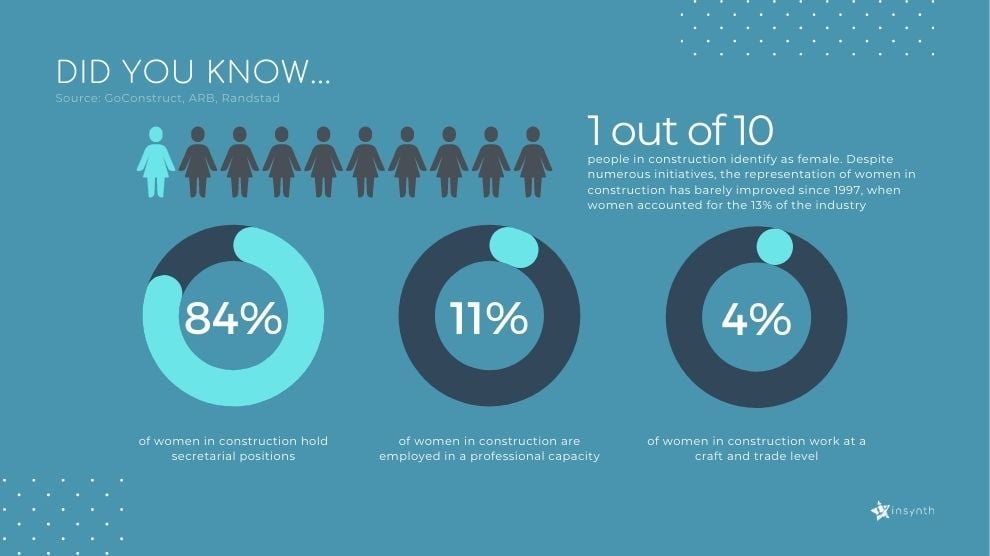
Taking A Close Look At The Industry
Whilst there has been a remarkable increase in the proportion of women joining different industries since the early 90s, the construction industry seems to struggle to catch up. It can be easy to get lost in the average advancements of other sectors when it comes to gender equality but, truth is, construction has still a long way to go.
If you ever wondered about the situation of women in the construction industry, here is some background data that will help you better understand the challenges the sector faces. In fact,
- Women make up around 14% of construction industry professionals
- This number is remarkably low when compared to the average among industries, where women occupy 46% of the jobs
- It is also disappointing, as predictions made in 2015 expected women to make up a quarter of the UK’s construction workforce by 2020
- Despite numerous initiatives, the representation of women in construction has barely improved since 1997, when women accounted for the 13% of the industry
- The majority of those women are directly employed, with only 4.2 % being self-employed
- If working for an employer, 84% of women hold secretarial positions, 11% are employed in a professional capacity and the remaining 5% are craft and trade level employees
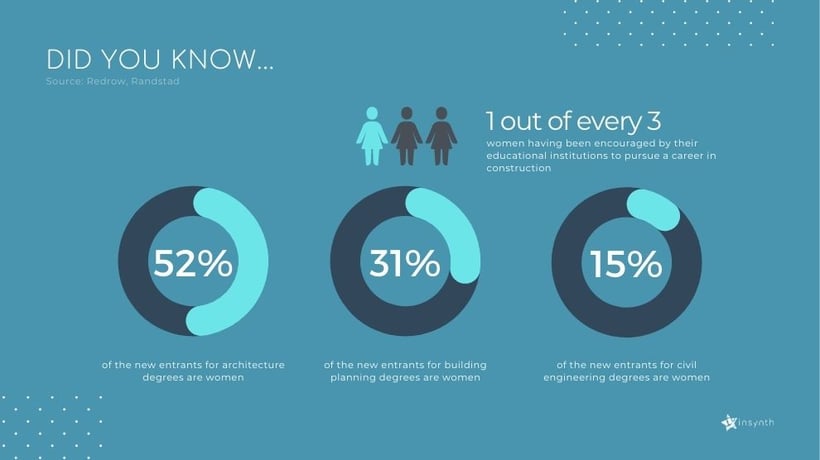
Young Women Are Discouraged From Pursuing Careers in Constructions
The current situation of women in the industry is inherently influenced by the perception young generations have of the sector, often portrayed as unfriendly and hostile for younger professionals and, most importantly, female professionals. The reputation of the industry has led educational institutions to discourage female students from pursuing a career in the sector, either through university or through professional colleges.
The fewer female students that are introduced to the industry, the fewer female professionals the sector will have in the upcoming year. If we look at the data, however, not everything seems to be lost! It has been observed that,
- During their time in school, 29% of women had been encouraged by their educational institutions to pursue a career in construction
- Despite this, Construction Manager Magazine reported an increase of 19% in female construction trainees in the academic year 2019/20
- Whilst 64% of male students report being encouraged by their schools to undertake an apprenticeship, this number decreases to 50% when looking at female pupils
- Once they get to university, degrees such as architecture, building planning, and civil engineering have witnessed an increasing number of female entrants, with 52%, 31% and 15%, respectively, being women
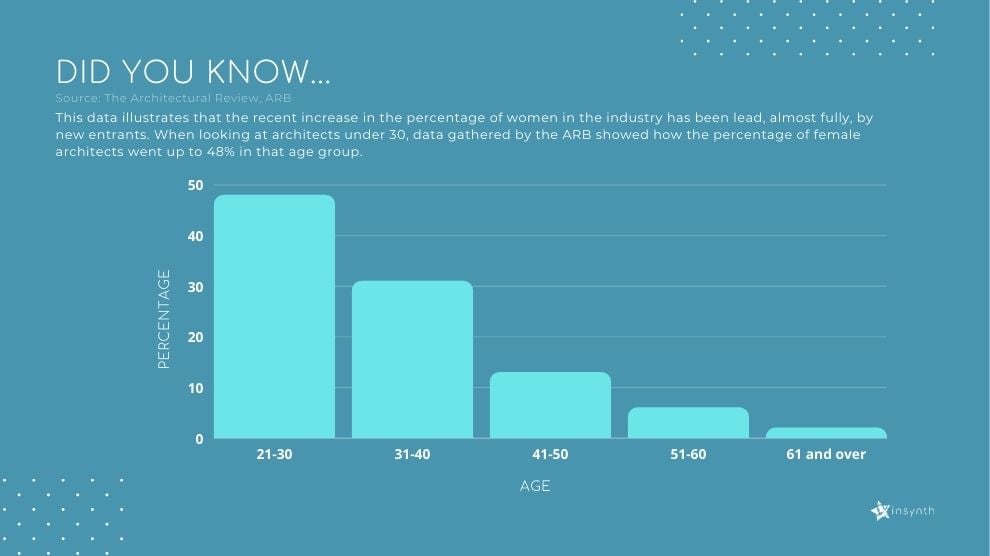
An Increase Of Young Female Professionals Ready to Change the Graphics
This willingness of younger generations to change the status quo has already prompted changes within the industry, observing a shift in entry trends! When looking at architects under 30, data gathered by the ARB showed how the percentage of female architects went up to 48% in that age group.
This data illustrates that the recent increase in the percentage of women in the industry has been lead, almost fully, by new entrants. As this trend mimics in the sectors of building planning and civil engineering, we should expect a change of direction in the upcoming years within the industry. With current data, we can see that
- Only 4% of tradespeople, 7% of CIOB members and 10% of chartered civil engineers identify as female
- According to Go Construct, 37% of new entrants choosing construction after university are women
These positive trends could be hindered if we note that women are, nevertheless, much more likely than their male counterparts to leave construction jobs, with only 23% of women staying in construction roles for longer than 6-10 years!
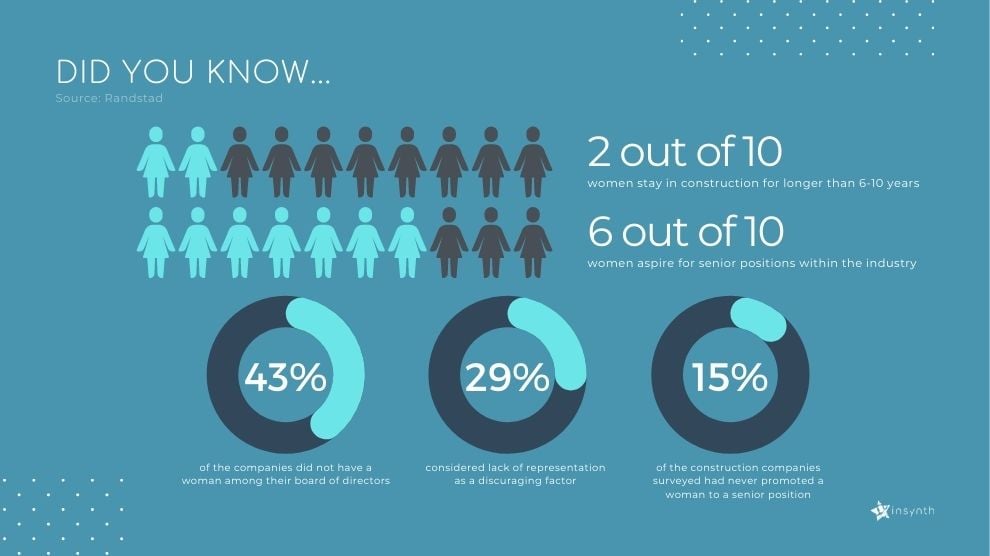
The Effect of Under-Representation in Senior Positions
When looking for referents, there is a flagrant lack of women in senior positions within the industry, preventing girls from feeling encouraged to introduce themselves to the construction sector. This affects not only students that are considering their first professional endeavour, but also women advanced in their professional lives that are looking for a change of career or, simply, a new direction.
The under-representation of women in the sector and, more importantly, in senior positions, is even more evident when looking at women from BAME backgrounds. To better understand the consequences of this issue, we have found that,
- When asked about the impact lack of representation in the industry could be having in the entry of women in the industry, 29% of women considered it an essential factor.
- A report by Randstad revealed that 15% of the construction companies surveyed had never promoted a woman to a senior position and 43% of the companies did not have a woman among their board of directors.
- Looking at the 10 biggest firms, Construction Manager Magazine reported that the proportion of women on the board of directors ranged from 12.5% at its lowest level, to 43%
- It is often pointed out that this is due to the personal choice that women leave the industry before they can be promoted. This is, however, simply not the case. Building magazine conducted a survey that found that 64% of women aspired to a senior leadership position.
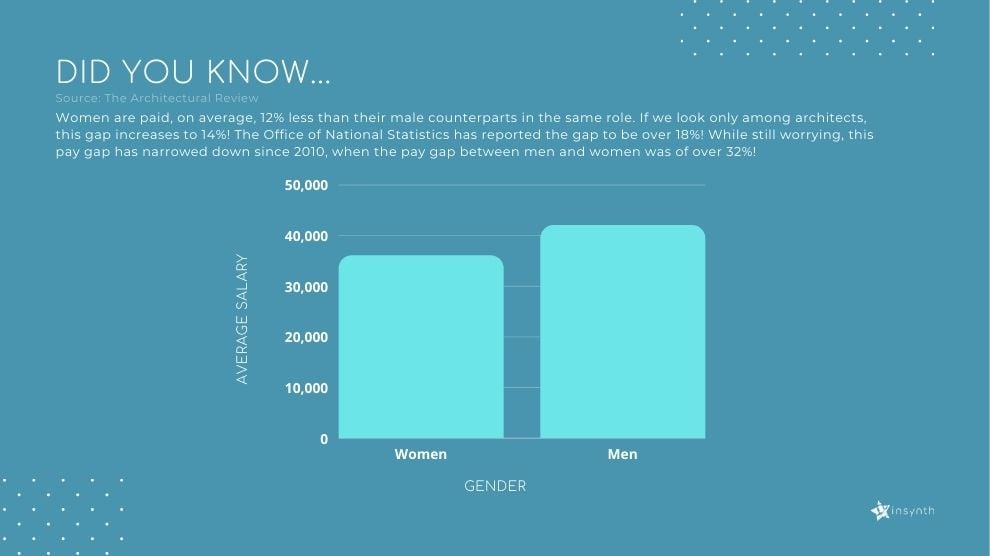
Closing The Pay Gap In Construction
A reason that is often put forward as the main factor why women decide to drop out of the industry is the difficulty to achieve a sustainable work-life balance. Nevertheless, a great proportion of women have reported financial reasons to play a heavy role when making that decision. The low number of women staying in construction after 30 is no surprise when we see the incredible pay gap they are experiencing.
- Women are paid, on average, 12% less than their male counterparts in the same role!
- If we look only among architects, this gap increases to 14%!
- The Office of National Statistics has reported the gap to be over 18%!
- While still worrying, this pay gap has narrowed down since 2010, when the pay gap between men and women was over 32%!
I know I am using quite a few exclamation points but... why wouldn't I?!
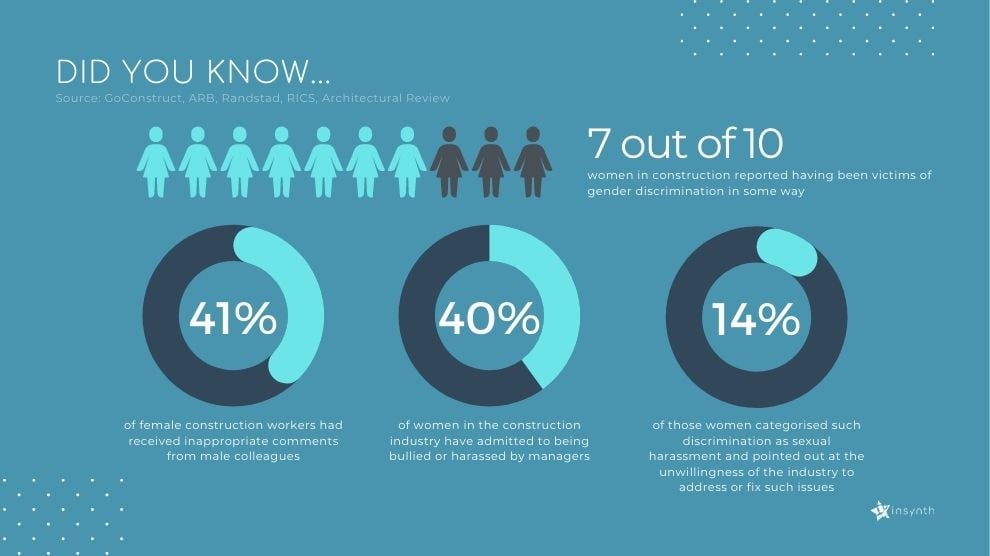
Calling Out Sexism In The Workplace
The other main reason women reported when explaining what had led them to leave the industry, sexism was brought up. Almost 1 out of every 3 women in construction reported in a survey by the RICS conducted in 2017 that the fear of being victims of sexism held them back from pursuing senior roles. And this fear is far from being unfounded.
- Through a survey conducted in 2017, Architectural Review identified that more than half of the women surveyed had experienced discrimination during the previous year, including sexism, bullying, and/or sexual harassment.
- Following a report published by Randstad in 2020, 72% reported having been victims of gender discrimination in some way.
- 70% of the reported harassment happened in the office.
- 63% of women had been passed over for a promotion or overseen for a particular project
- 41% of female construction workers had received inappropriate comments from male colleagues
- 40% of women in the construction industry have admitted to being bullied or harassed by managers
- 30% revealed they were too afraid to make a complaint about the treatment they suffered
- 14% of those women categorised such discrimination as sexual harassment and pointed out the unwillingness of the industry to address or fix such issues
Our Effort to continue the conversation
As the first inbound digital marketing agency focused on construction, for International Women's Day, we have asked Olivia Atkinson, a senior member of the team, to tell us about her experience being involved with the construction industry and how these last four years in the sector have changed her perception regarding all-things-construction.
We have recorded the conversation with Olivia for our newly released podcast SNAGGED, where we offer solutions to the marketing and sales challenges construction product business leader experience. You can check previous episodes here.
About Insynth
At Insynth we deliver a predictable flow of leads, customers, and specifications for building product brands through our inbound marketing approach, proven to reach a technically demanding audience.
We use the latest marketing techniques such as construction inbound marketing, to equip building product companies to grow sustainability in this era of digital transformation.
As the only HubSpot certified agency to major in construction marketing. We have a proven formula of bringing a variety of functionalities together including CRM Implementation, Web Design, Sales Automation, SEO, and Email Marketing to achieve your ultimate aim: Growing your business and gaining new specifiers and customers.
